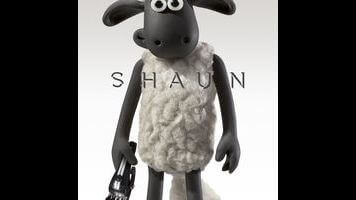Animation fans may enjoy the relative silence of Aardman’s Shaun The Sheep

Despite technology that can bring wondrous imagery to all manner of animation studios, plenty of kid-targeted cartoons feel as if they’ve been inexplicably paid by the word. Even ostensibly talk-light characters like Despicable Me’s Minions star in movies that place a premium on narration, explanation, and frenzied verbal jokes, often screamed. Aardman Animations, the British studio behind Wallace, Gromit, and plenty more, has a droller dialogue voice than most, yet it also understands how animation is well suited for silent (or at least English-free) comedy. The character Shaun, star of a TV series and now the accompanying Shaun The Sheep Movie, falls closer to Gromit than Wallace on the talking spectrum, leading his flock of fellow sheep with a resourcefulness that requires no more chatter than the occasional “baaaa.”
Of course, this decision may not be entirely based in rigorous adherence to classic animation values. The lack of dialogue makes Shaun The Sheep easy for younger children all over the world to understand, and the film is undeniably intended for that demographic. It’s a far less complicated operation than many other Aardman projects, paring down the Rube Goldberg-ish slapstick and eliminating the British-accented wordplay of the studio’s best work. But even attempting to entertain children who might get fidgety during the more explicitly British Curse Of The Were-Rabbit or The Pirates! Band Of Misfits, Aardman locates and meets a formal challenge. With sound limited primarily to animal noises, human grunts, and Great Escape-like theme music, it creates a farm where virtually all of the side characters—a duck who accepts bread-based bribes, rude and confrontational pigs—provide moments of delight.
Because this is a feature film, Shaun and his sheep friends must venture outside the farm. The movie opens with a montage establishing the daily routines of the unnamed Farmer and his faithful assistant dog, Bitzer, as they manage Shaun’s flock. Repeatedly taking inspiration from advertisements on the sides of buses, Shaun decides that the sheep deserve a break from this monotony, and they conspire to distract Bitzer and Farmer. They want only to laze around Farmer’s house and watch some TV, but a series of mishaps results in the Farmer sitting in hospital with amnesia, with Bitzer, Shaun, and the others combing the city to find him.
It’s possible that the Shaun The Sheep cartoons from television offer more context for the relationship between Farmer and his livestock, or the half-antagonistic, half-collaborative bond between Shaun and Bitzer; here, both seem a little too businesslike to fulfill their apparent obligations as the film’s emotional pivot points. But that doesn’t matter as much as the film’s bouncy slapstick episodes, like a walk through the ruffian-populated halls of an Animal Control jail or the amusing business of Bitzer nearly performing surgery while dressed as a doctor.
Amusing rather than hilarious, Shaun The Sheep doesn’t represent Aardman at its creative peak; rather than Chicken Run, the company’s previous foray into livestock, it plays more like Sheep Stroll. Shaun, while fitting perfectly into the studio’s tradition of cute-ugly endearment, isn’t Aardman’s most inspired character, and the movie blurs the individual sheep personalities during a long section that forces them into human disguises. Every once in a while, the movie delivers a laugh big enough to dwarf its more modest charms—further emphasizing that this is junior-level Aardman. Not that there’s anything wrong with that; littler kids certainly deserve movies this gentle, funny, and quietly inclusive (the movie’s big-city human players include people of all colors, as well as what appears to be a gay couple). Maybe it can even mold young minds, teaching that animation doesn’t have to yammer incessantly to get their attention.